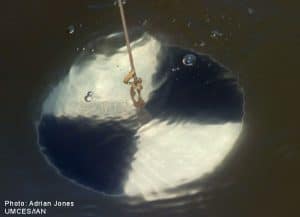The universal tool for measuring water clarity is called a Secchi disk. A Secchi disk is an 8 inch diameter plate with alternating black and white quadrants. This disk is attached to a rope and slowly lowered into the water column until the disk is no longer visible to the naked eye. The resulting reading is the Secchi depth or transparency of the water. Secchi disks are inexpensive and readily available from many online sources.
Secchi disks are a valuable tool for monitoring certain parameters of your pond or lake. In a high priority fishing lake, the disk can be used to measure the “bloom” or phytoplankton production in the lake. Phytoplankton provide the base of the food chain for quality production of forage fish. As you go up the food pyramid, this ultimately results in fatter, healthier bass. The recommended Secchi depth in this case is 18-24 inches. Should you have Secchi readings of greater than 24 inches, then fertilizer might be considered as an option for stimulating a plankton bloom. However, liquid or granular pond fertilizer should NEVER be applied in the presence of heavy algae or submersed weed growth.

Secchi Disk Submerged Image Courtesy of Adrian Jones
In urban retention ponds, it is not recommended to apply fertilizer. These ponds are designed to capture storm water runoff which is already full of phosphorus and nitrogen. Adding additional nutrients will only lead to severe algae outbreaks. In this scenario, a Secchi disk can be used to gauge sunlight penetration. Without sunlight, it is hard for algae and submersed weeds to get established. We typically recommend the Secchi depth to be less than 18 inches in urban ponds. If readings are greater than 18 inches in your community pond, then the use of non-toxic pond dyes should be considered to reduce sunlight penetration which favors noxious growth. Pond dyes should only be used in closed pond systems with minimal overflow.
And finally, Secchi disks can be used to monitor the degree of suspended clay particles in your pond. Community ponds are commonly plagued by muddy water caused by the erosion or runoff of loose soil within disturbed watersheds (see our page on clearing muddy ponds). Most often, the absence or failure of proper erosion control barriers around development sites is the culprit. Taking Secchi readings can establish a baseline for water clarity. This baseline reading can be used to determine when and how measures should be taken to improve the aesthetics of the pond. In ponds with Secchi readings less than 6 inches, it may be recommended to apply a flocculant such as alum to improve water clarity. Alum should only be applied by a qualified lake management professional.
For more about Secchi disk use, here’s a link to the EPA’s web archive.
